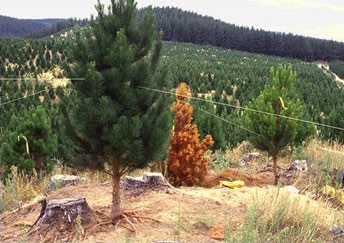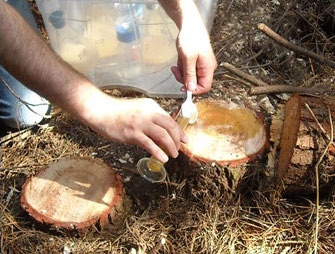PESTS AND DISEASES OF FORESTRY IN NEW ZEALAND
A biological control for armillaria root disease?
Scion is the leading provider of forest-related knowledge in New Zealand
Formerly known as the Forest Research Institute, Scion has been a leader in research relating to forest health for over 50 years. The Rotorua-based Crown Research Institute continues to provide science that will protect all forests from damage caused by insect pests, pathogens and weeds. The information presented below arises from these research activities.
From Forest Heallth News 245, March 2015
Armillaria species are found naturally in indigenous forests where they generally occur as harmless wood decay fungi. However, in exotic pine stands some are significant pathogens and cause growth loss and mortality in infected trees. Armillaria root disease was once a serious problem when pine stands were established on land cleared of indigenous forest. Although of less concern in current plantations, the main pathogen, A. novae-zelandiae, remains widespread in many forests. As a result, the disease still appears unexpectedly in particular stands, leading to enquiries from growers wanting to know what they should do.

We have been running a small research programme for a number of years aimed at providing an integrated control procedure as an alternative to the costly, but effective, recommendation of removing stumps before establishing the next crop. Methods that have proved successful in reducing disease incidence significantly include the planting of vigorous healthy stock1 and timely treatment for dothistroma needle blight. Disease levels were not reduced by silvicultural thinning and a search for genetic resistance has so far proved unavailing. It was therefore decided to try biological control as a further option.
Armillaria novae-zelandiae is able to overcome the resistance of healthy hosts by colonising and growing within the wood provided by tree stumps. Other fungi also naturally colonise pine stumps and compete with Armillaria species for the same wood substrate. By increasing the incidence of these fungi, in order to give them a competitive advantage, it might be possible to confine Armillaria species to insignificant segments of the stump, limiting their ability to cause disease (see Forest Health News: 241: 1-2).
Two studies were undertaken in which freshly cut Pinus radiata first thinning stumps were treated at opposing positions with an isolate of A. novae-zelandiae, on the one hand, and one of the following wood decay fungi, on the other: Ganoderma applanatum, Hypholoma acutum, H. fasciculare, Phlebiopsis gigantea, Resinicium bicolor, Rigidoporus concrescens, Sistotrema brinkmannii and Stereum sanguinolentum. Treatments were applied either as wooden dowel cultures inserted into drill holes or as an aqueous macerated mycelial suspension spread over the cut stump surface. Stumps were harvested and examined after periods of between one and two years.

Despite being inoculated, Armillaria was isolated from stumps at a low frequency, and did not differ significantly in incidence between the various treatments, including the controls. This may imply some level of resistance to pathogen invasion in new stumps. Nevertheless, the study also showed that treatment had tangibly boosted stump colonisation by some of the potential control fungi, which were isolated more frequently from inoculated stumps than from untreated controls. Results indicated that the two common pine fungi, P. gigantea and S. sanguinolentum, in particular, should be tested further. Future work would evaluate the presence of Armillaria within the root system and root collar zones, where incidence may be greater, rather than in the stump as a whole. It is from those zones that the pathogen attacks the roots of healthy trees.
The work in this article is reported in greater detail in: Hood, I.A.; Oliva, J.; Kimberley, M.O., Arhipova, N.; Bakys, R. (2015): Armillaria novae-zelandiae and other basidiomycete wood decay fungi in New Zealand Pinus radiata thinning stumps. Forest Pathology. doi: 10.1111/ efp.12171.
Ian Hood
1Hood, I.A.; Kimberley, M.O.; Gardner, J.F. (2006): Stock-type susceptibility and delineation of treatment areas for a cryptic Pinus radiata root disease. Phytopathology 96: 630-636.
2Bulman, L.S.; Gadgil, P.D.; Kershaw, D.J.; Ray, J.W. (2004): Assessment and control of Dothistroma needle-blight. Forest Research Bulletin No. 229, 48 pp. Rotorua, New Zealand: Forest Research Institute.
This information is intended for general interest only. It is not intended to be a substitute for specific specialist advice on any matter and should not be relied on for that purpose. Scion will not be liable for any direct, indirect, incidental, special, consequential or exemplary damages, loss of profits, or any other intangible losses that result from using the information provided on this site.
(Scion is the trading name of the New Zealand Forest Research Institute Limited.)

 Farm Forestry New Zealand
Farm Forestry New Zealand

